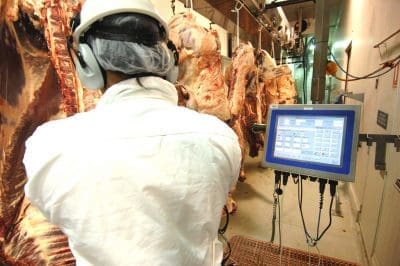THE general trend in direct consignment grid pricing in northern regions is down this week, as supply pressure continues to mount, in the face of processing labour capacity limitations.
Some large Queensland processors have dropped rates another 10c/kg since Friday, while others remained unchanged, or have sat-out of the market for a period, knowing their July bookings are already well covered. Some Queensland processors who have not changed pricing this week in fact dropped rates by 20-30c/kg the previous week, meaning there is a degree of catch-up involved.
 Congestion in northern NSW and Queensland plants is clearly a factor now, with some operators only taking significant bookings (unpriced in some cases) for week 32, starting 5 August. Other still have some slots available for later in July.
Congestion in northern NSW and Queensland plants is clearly a factor now, with some operators only taking significant bookings (unpriced in some cases) for week 32, starting 5 August. Other still have some slots available for later in July.
Part of the growing backlog in bookings is being driven by some particularly large consignments of 20-50 decks, in some examples discussed this morning. One particularly large deal involved 70 decks. It does not take many large deals like that for kill rosters to rapidly fill-up, and northern and western Queensland is currently responsible for a growing proportion of kills stretching from the NSW border all the way to Townsville.
“We’re seeing more 8-12 deck lots out of western and northern areas, and less 2-4 decks at present,” one Queensland processor cattle buyer said this morning. “It can fill a daily roster very quickly.”
Some of those cattle had been held back a little by earlier weather problems, condensing supply during the middle part of the year this year a little more than normal.
Grid prices trend down
Current direct consignment grids for competitive processors in southern Queensland have good, well-finished heavy cows on 420-430c/kg, and four-tooth heavy grass steer on 490-500c/kg, with implant.
Central Queensland plants are 10-20c behind those rates, but are coming under mounting supply-side pressure as conditions dry off.
In southern states, grids in eastern parts of South Australia have risen, with heavy grass steers at 590c and good cows 530c this week. Southern regions of NSW have cows 500c and 600c for good grass heavy steers, reflecting current mid-winter local supply. That’s in turn pushing more southern processor buyers north into Queensland to supplement their local cattle access.
Weekly kills edge higher
MLA’s seven-day national slaughter report for the week ended Friday produced a new 2024 season-high for adult cattle slaughter, reaching 142,390 head. Most southern states were sharply higher in volume, because of a Monday public holiday the previous week.
The big surprise was Queensland, where there were some significant equipment problems at three large plants last week – mostly to do with rendering equipment. It doesn’t take long for rendering material to build up in a beef plant if breakages arise, and that happened last week, curtailing some shifts.
None of the rendering equipment used by the industry is cheap, with a new cooker (a large piece of equipment used for meatmeal production and extraction of tallow) now costing $4 million or more.
Despite the disruptions, Queensland’s kill last week reached almost 74,000 head, not far short of its 2024 season high. Reflecting the general lack of killable cattle in southern parts of Australia, Queensland last week accounted for almost 52pc of the national total.
With the normal mid-winter supply lull in evidence, some southern plants schedule their routine mid-winter maintenance closures, mostly for a week. Queensland plants tend to schedule their maintenance closures during the summer months, when local supply declines.
As discussed yesterday, lean trimmings prices into the US have mounted a small price recovery, and some cuts business is improving, especially into North America, exporters say.
Saleyards
Most saleyards operating early this week maintained or raised numbers, despite the approach of end of financial year.
Wagga sale yesterday yarded 4425, similar to last week. The market rallied for secondary steers as buyers bid to higher price levels compared to the previous sale. Heavy steers 500-600kg mostly sold from 320-402c/kg. In the export market, competition was patchy, with some cattle looking wintery. Heavy steers and bullocks sold between 240-352/kg. Due to a shortage of heavy steers and bullocks, processors focused their buying on big heavy heifers. Prices lifted 18c to average 313c/kg. Heavy cows sold from 220-260c, with leaner types from 175-205c.
Gunnedah this morning yarded 2100, down 800 on last week. Cows were dearer throughout, with heavy cows to 247c and medium weights making 190c. Most cow values rose by 23-28c/kg.
Wodonga this morning yarded 1020, similar to last week. Quality across all classes was plain, with prices distorted due to the limited supply of finished stock. Cows were highly sought-after with demand strong across most classes. In the export market competition was considerably weaker. Heavy steers sold from 285-310c, while bullocks sold significantly cheaper to average 294c. The big offering of cows encouraged buyers to step up for all weights and grades and prices remained strong throughout the sale. Heavy cows sold from 245-264c/kg, with leaner grades rom 174-210c.
Numbers jumped by 2300 to 8274 at Roma store sale this morning. Despite the quality offering prices continue to soften, most notably in the secondary lines. At the time of this interim report grown steers 400-500kg sold to 230c/kg, and steers 500-600kg also to 230c. Steers over 600kg sold to 274c/kg. Full report tomorrow.
